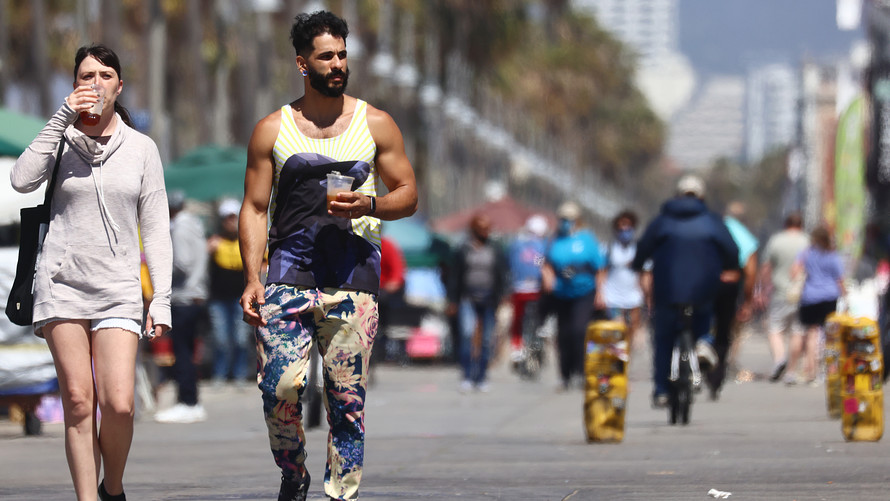Wear a mask. Don’t wear a mask. Make one. Buy one. Wear it outdoors. Wear it indoors.
Confused? You’re not alone.
So what’s the deal with the CDC’s new guidance? In an effort to help combat the highly contagious delta variant, the Centers for Disease Control and Prevention said Tuesday that people should return to wearing masks in regions where coronavirus cases are surging.
“The delta variant is showing us every day its willingness to outsmart us,” Dr. Rochelle Walensky, director of the CDC, told the press conference. “The delta variant behaves in uniquely, different from past strains of the virus that cause COVID-19.”
“ ‘The spread of the delta variant and a large minority of vaccine holdouts is a game-changer for unmasked vaccinated Americans.’ ”
Vaccines from Johnson & Johnson JNJ, +0.46% Pfizer-BioNTech PFE, +0.69% and Moderna MRNA, -2.19% have helped to slow the spread of the virus, but the delta variant and a large minority of vaccine holdouts is a game-changer for vaccinated Americans.
The delta variant accounts for approximately 83% of all U.S. coronavirus cases, and 99% of COVID-related deaths are among the unvaccinated. Whatever way you analyze the figures, we are still far, far away from normal, particularly for areas such as Arkansas, Florida and Louisiana.
The advice is hardly definitive, but nor is delta exclusive to those states where cases are on the rise. It has spread all over the U.S. Those living in states where a majority of people are vaccinated, such as New York, will understandably take these guidelines to heart and mask up. Again. If in doubt, why take chances?
You can take off your mask except where required by federal, state, local, tribal, or territorial laws, rules and regulations, including local business and workplace guidance. You still need a mask on buses and trains, in museums and most stores, possibly at your place of work, but not inside restaurants, except when you’re on your way to the rest room.
Another dilemma: How do you know if a maskless person is vaccinated? It’s an honors system. The CDC guidance gives more reason for people to abide by that old American Express slogan: “Don’t leave home without it.” Yet people are leaving home without their masks, and getting on planes and refusing to mask up.
Private organizations have agency to make their own rules. For summer camps, the CDC says: “Camps may also choose to continue to require masks for vaccinated, and not fully vaccinated campers and staff in order to adhere to prevention strategies when it is difficult to tell who has been vaccinated or to set an example for not fully vaccinated campers.”
The Moneyist: Is it ethical for cruise lines, venues, schools or Broadway to restrict entry to people not vaccinated against COVID-19?
The one consistent part of the pandemic is that everything — mask policy, included — is subject to change. This is the latest of many U-turns by the CDC. Walensky previously said the vaccinated could ditch the masks outdoors and indoors, when they were among other vaccinated people. “We have all longed for this moment when we can get back to some sense of normalcy,” she said in May.
In April 2020, the Trump administration and the CDC reversed their policies on face masks, and said all Americans should wear cloth face coverings and not — as officials previously said — just medical workers. Former President Donald Trump cited “recent studies,” while the CDC cited “new evidence.”
That U-turn most of all was, perhaps, hard for many people to swallow. Forgive the public for having mask rules fatigue. We’ve been on quite a journey. Studies earlier in the pandemic suggested that adopting the practice of mask wearing, one that was already accepted in many Asian cultures, would have saved tens of thousands of lives.
“ ‘You still need a mask on buses and trains, in museums and most stores, possibly at your place of work, but not inside restaurants, except when you’re going to the rest room.’ ”
Here’s a brief flashback to what happened: Dr. Nancy Messonnier, director of the Center for the National Center for Immunization and Respiratory Diseases, said in a briefing on Jan. 30, 2020, “The virus is not spreading in the general community. We don’t routinely recommend the use of face masks by the public to prevent respiratory illness. And we certainly are not recommending that at this time for this new virus.”
Three months later, however, the country had an unpleasant needle-scratching-vinyl moment when New York Gov. Andrew Cuomo, a Democrat, ordered all New Yorkers to cover their faces in public when they can’t maintain a proper social distance.
Many people were and are fed up. Little wonder: According to a New York Times survey in May, 29% of epidemiologists surveyed thought people would be wearing masks in public spaces for at least another year, while 26% said they believed people would do so for another year. However, another 26% said they thought mask wearing would continue in some form from now on.
The CDC’s latest mask announcement are just guidelines and, despite criticism from some members of the press, Walensky is not afraid to change the guidelines when the science changes. One person’s perception of indecisiveness is another’s ability to act boldly, if not always consistently, in a public-health crisis. Because that is the nature of the beast.
It’s up to individual states to decide what to do next. As it stands, a paltry eight states — including California, New York and Washington — require people who are not fully vaccinated to wear face masks in most indoor public settings, the AARP points out.
But the consistency that some commentators crave can be overrated. Case in point: nearly a dozen states did not impose any mask mandate during the pandemic, despite the evidence that they help slow the spread of the virus. Alaska’s Department of Health and Social Services, for instance, “strongly encourages the wearing of masks in public,” but state lawmakers have not required it.
The mixed reaction to each announcement by the CDC illustrates the tension, fear and frustration not only with state laws and changing guidance, but with each other. Stock markets don’t like uncertainty, and neither do human beings. And while some folks don’t abide by mask guidelines at all, more than a year into the pandemic most Americans are doing the best they can.
(This story was updated on July 27, 2021.)

People walk along the Venice Beach boardwalk on April 28, 2021 in Venice, Calif.
Getty Images







